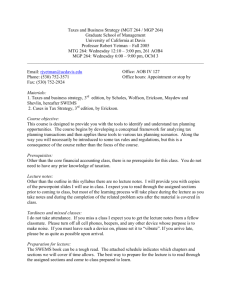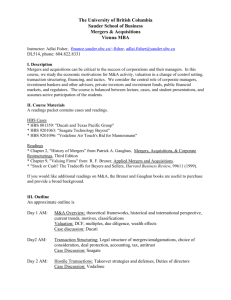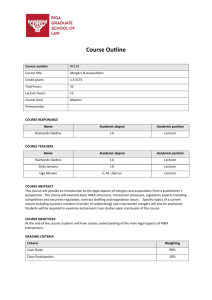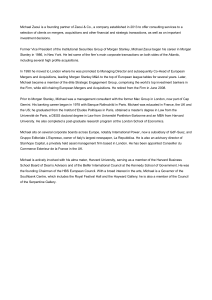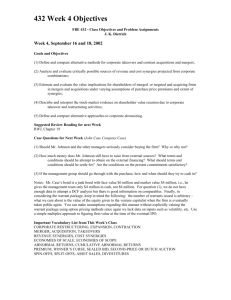Topic 3. Organization of mergers and acquisitions
advertisement
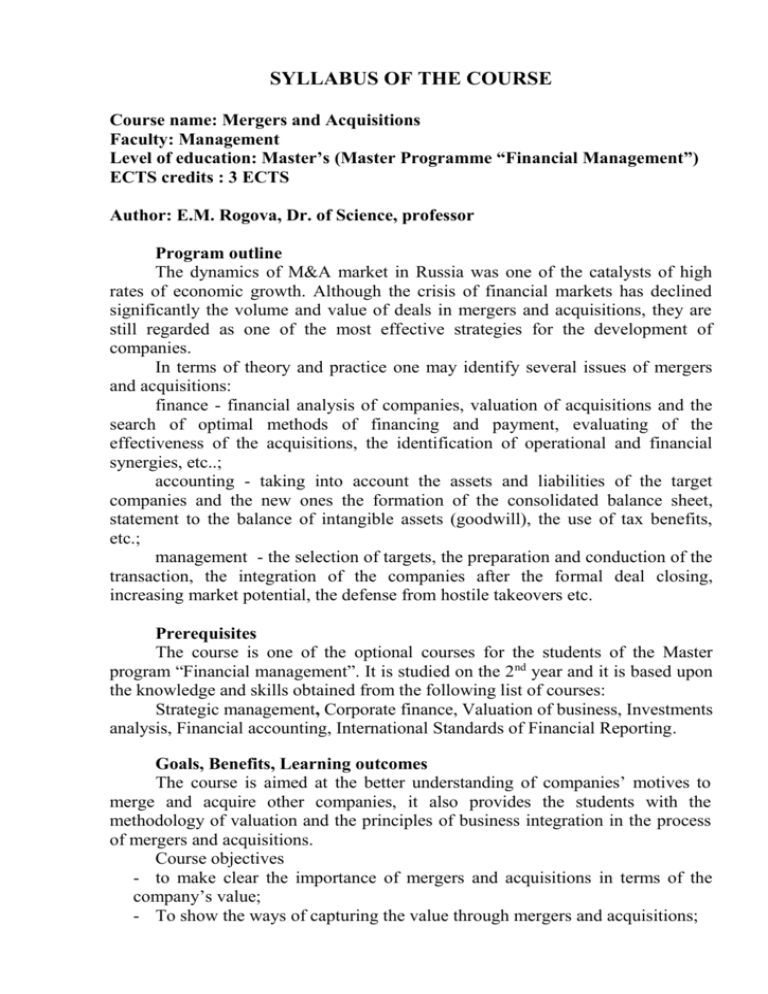
SYLLABUS OF THE COURSE Course name: Mergers and Acquisitions Faculty: Management Level of education: Master’s (Master Programme “Financial Management”) ECTS credits : 3 ECTS Аuthor: E.M. Rogova, Dr. of Science, professor Program outline The dynamics of M&A market in Russia was one of the catalysts of high rates of economic growth. Although the crisis of financial markets has declined significantly the volume and value of deals in mergers and acquisitions, they are still regarded as one of the most effective strategies for the development of companies. In terms of theory and practice one may identify several issues of mergers and acquisitions: finance - financial analysis of companies, valuation of acquisitions and the search of optimal methods of financing and payment, evaluating of the effectiveness of the acquisitions, the identification of operational and financial synergies, etc..; accounting - taking into account the assets and liabilities of the target companies and the new ones the formation of the consolidated balance sheet, statement to the balance of intangible assets (goodwill), the use of tax benefits, etc.; management - the selection of targets, the preparation and conduction of the transaction, the integration of the companies after the formal deal closing, increasing market potential, the defense from hostile takeovers etc. Prerequisites The course is one of the optional courses for the students of the Master program “Financial management”. It is studied on the 2nd year and it is based upon the knowledge and skills obtained from the following list of courses: Strategic management, Corporate finance, Valuation of business, Investments analysis, Financial accounting, International Standards of Financial Reporting. Goals, Benefits, Learning outcomes The course is aimed at the better understanding of companies’ motives to merge and acquire other companies, it also provides the students with the methodology of valuation and the principles of business integration in the process of mergers and acquisitions. Course objectives - to make clear the importance of mergers and acquisitions in terms of the company’s value; - To show the ways of capturing the value through mergers and acquisitions; - To give some skills in evaluation of target companies and the deals’ value; - To help the managers to attract funding for mergers and acquisitions; - To learn about innovative financial decisions in mergers and acquisitions’ funding strategies; - To find the ways of value growth through integration of merging companies; - To give some ideas about the defense strategies in the cases of the hostile takeovers attempts. The students would acquire the following competencies: The knowledge of: The basic principles of valuation of mergers and acquisitions, the sources of synergies, the types of risks inherent in this type of activity, the main methods of financing mergers and acquisitions and methods of protection against hostile takeovers. The ability: To analyze mergers and acquisitions of various types, to determine the degree of the optimal structure of such transactions, to choose methods for deals’ funding, to determine the sources of synergies and the risks of mergers and acquisitions, to compose consolidated balance of the merged company. The skills: Work with accounting reports, the evaluation of investment decisions in mergers and acquisitions, the decision-making in respect of assets and sources of commercial organization. Distribution of hours The course consists of 16 classes (4 academic hours each) with 116 hours for self-study. Course content Topic 1. Mergers and acquisitions as a part of strategic development of a company: motives, benefits, risks The concept of mergers and acquisitions (M&A). Criteria of definition of M&A deals. M&A in the Russian legislation (specific features): the forms of reorganization of legal entities. Classification of mergers and acquisitions: the acquisition of control, the degree of control, way of integration, attitude to the target company. The M&A market: the cycles of development, distribution by countries and sectors of economy. Russian market of mergers and acquisitions: the stages of development, performance, specific features. MARX indexes. The main objectives and motives of mergers and acquisitions: operational, financial, investments, strategic and specific objectives. Topic 2. Valuation of M&A effectiveness The concept of synergy. Operational and financial synergic effects. Types of operating sinergies. Types of financial synergies. Valuation of the company in the process and after the merger. The impact of M&As at the performance of the company. Determining the intrinsic value of a target company. Advantages and disadvantages of different forms of payment, and their impact at the effectiveness of mergers and acquisitions. Evaluation of the effects of mergers and acquisitions (economies of scale, tax revenues, lower cost of capital). "Pitfalls of growth” and their assessment. Formation of the consolidated balance sheet of the company. Reflection of mergers and acquisitions in various financial reporting standards. Accounting for intangible assets (goodwill) by the purchase method and pooling method packages. Effect of mergers and acquisitions in the tax burden of companies. M&A impacts on the dividend policy of the company. Topic 3. Organization of mergers and acquisitions The main stages of mergers and acquisitions. The role of investment banks in organization of the deals of mergers and acquisitions. Creating value through mergers and acquisitions. "Pyramid" of a value creating by McKinsey and its application in Russia. Integration of companies in mergers and acquisitions. Compatibility issues of production, financial, organizational structure, personnel, organizational culture. The reasons for failures of mergers and acquisitions. Basic principles of integration. Topic 4. Hostile Acquisitions Criteria of hostile takeovers. The causes of hostile takeovers. Impact of hostile takeovers on the performance of the company. The theory of "performance management". Costs of hostile takeovers. Methods of protection against hostile takeovers. Classification of methods. Preventive methods. Legal methods. Possibilities of methods of protection in the growing post-age conditions. Government efforts aimed at combating the illegal seizure of enterprises-appropriate interventions. Protecting the interests of investors in privatization transactions. Protection of minor shareholders interests. Topic 5. Methods of funding the deals connected with mergers and acquisitions Funding from retained earnings and its effect on the shareholders’ interests. Fundraising through initial public offering (IPO) and through private placement. Funding from credit sources and loans. Mezzanine funding. The applications of mixed methods of financing and financial engineering. Joint ventures and strategic alliances as an alternative to mergers and absorption. MBO and redemption of the company on credit (LBO). Effects of MBO and LBO. The motives of managers. The procedure for redemption and its relationship with the dividend policy of the company. Assessment Type of testing Form of testing Parameters Current Students’ activities Intermediate Homework The students’ individual and group work at the seminars and tutorials in the form of case analysis, presentations, problems solving etc Case analysis of a deal, its presentation Final test Written test and following discussion Test consists of questions and problems solving Reading materials DePamphilis D.M. Mergers, Acquisitions and Other Restructuring Activities. – 5th Ed. Academic Press, 2010 Bruner R.F. Applied Mergers and Acquisitions. John Wiley and Sons, 2004. Brealy R., Myers S. Principles of Corporate Finance. 7th Ed. – McGraw-Hill, 2003. Contact person Prof. Elena Rogova rogova@hse.spb.ru

